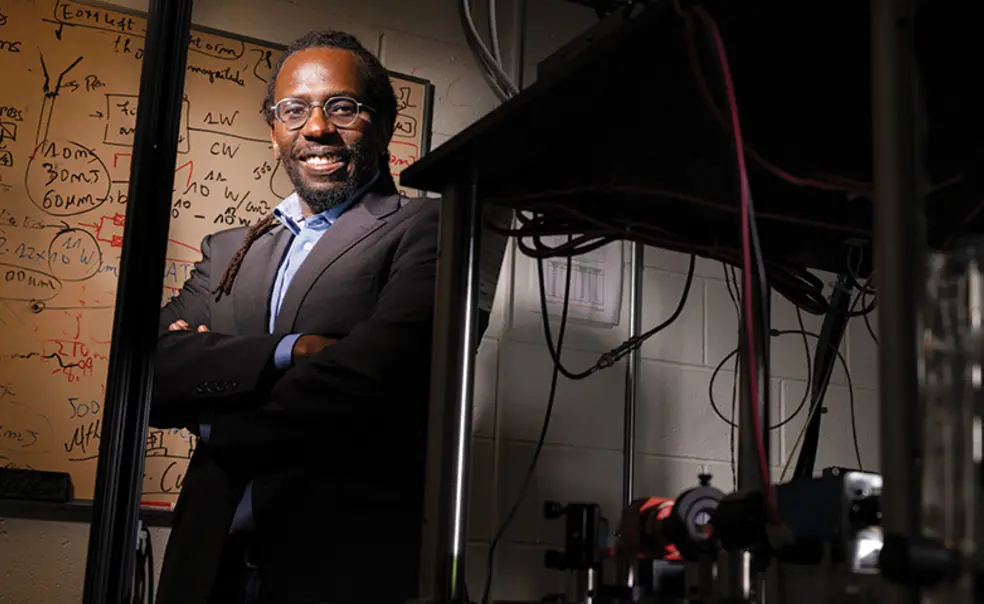Chasing Fusion With the Princeton Plasma Physics Laboratory’s Ahmed Diallo
The idea of cheap, accessible, and limitless energy was imparted on Ahmed Diallo at a young age. A principal research physicist at Princeton Plasma Physics Laboratory (PPPL), Diallo is a native of Burkina Faso in West Africa, one of the poorest nations in the world, where rural areas have a 3% electrification rate.
“I grew up in an urban area, but electricity was intermittent and much more expensive than in the U.S.,” says Diallo. He draws parallels between his homeland’s urgent need for resources and the Earth’s need for new power solutions as motivation for his research.
Last summer, Diallo worked in Cadarache, France, overseeing installation of diagnostic tools for the measurement of plasma temperature and density inside the W Environment in Steady-state Tokamak, or WEST. “W” is the symbol for the chemical element tungsten, and a tokamak is a device that confines plasma and holds the greatest potential for commercial controlled fusion energy. Last year, Diallo was part of a team awarded a $1.6 million grant from the U.S. Department of Energy (DOE) to research the use of tungsten in WEST. Tungsten is a rare gray metal and when turned into a fine powder is flammable and can spontaneously ignite.
“At PPPL, we’re building an impurity power dropper, a tool used to coat the plasma-facing wall of the WEST device, a process expected to significantly enhance the machine’s performance,” Diallo says.
WEST is the predecessor of the International Thermonuclear Experimental Reactor (ITER), the largest-ever fusion device, a tokamak with 10 times the plasma volume of any of its contemporaries. An agreement to build ITER was reached in 1985 with the aim of supplying the world with limitless, carbon-free energy from nuclear fusion by 2025. All 27 European Union countries plus China, India, Japan, South Korea, Russia, and the U.S. are members of ITER. The mega-tokamak is billions of dollars over budget and many years behind schedule though. Construction began in 2010, with the original first plasma turn-on date set for 2018, but in 2016 the ITER council pushed the launch date to 2025. In the first half of 2023, the ITER council announced that the timeline would be revised yet again.
“Lately, it’s like all of humanity’s creative powers have joined forces to find alternative sources of energy,” Diallo says.
Diallo came to the U.S. to pursue a bachelor’s degree in physics from the University of Montana. He was drawn to the school by the “cost, the appeal of the mountain region, and a good recruiting job by the university’s admissions office,” he says. He did his Ph.D. at the University of Iowa, landed a postdoc position in Switzerland and a fellowship in Australia before returning to the U.S. to join PPPL in 2009. Last year, he became a program director for the Advanced Research Projects Agency-Energy, where he focuses on transformative research and development to enable commercial fusion energy. Diallo has received a number of awards, including the DOE’s Early Career Research Program Award and the 2022 DOE Oppenheimer Fellowship.
Part of a team of about 700 at PPPL, Diallo remains focused on the upgrade of the National Spherical Torus Experiment (NSTX), Princeton’s own magnetic fusion device. He’s also part of a team working on developing a new method that prevents damage to the mirrors used in semiconductor chip manufacturing.
In 1994, Princeton researchers performed the first controlled fusion experiment that produced significant power, heating plasma to around 300 million degrees Celsius. WEST has already set a world record, fusing plasma for six minutes and 30 seconds — injecting and extracting over 1,000 megajoules of energy in the process.
“Our own reactor validates the physics of the spherical tokamak, which will enable the design of a future fusion power plant. Then, we can go to WEST and hone the skills needed for the development of future devices,” says Diallo.
Prior to visiting France, Diallo spent a few days in Seville, Spain. PPPL has been awarded a $5.1 million DOE grant to help develop the Small Aspect Ratio Tokamak (SMART), a new spherical tokamak the University of Seville is constructing. “This device should also provide a nice platform for PPPL to test novel ideas,” he says.
“But what I’m doing in Seville is not strictly helping them. I’m also learning by working with them, and all this will definitely come back to Princeton.”












No responses yet